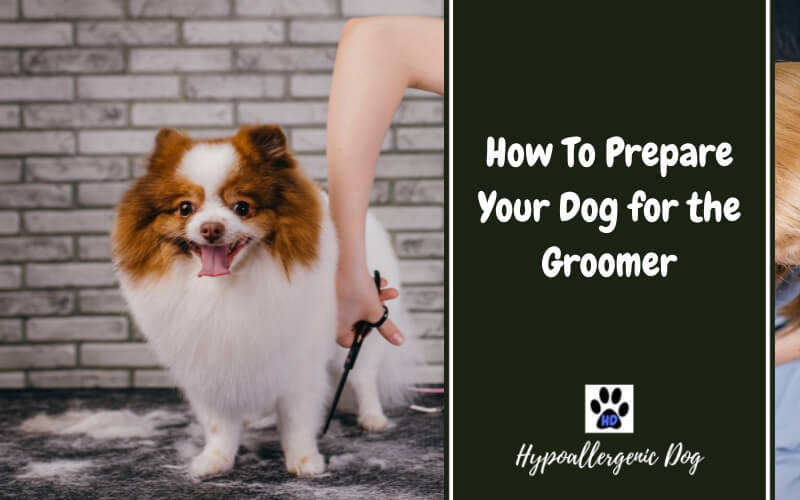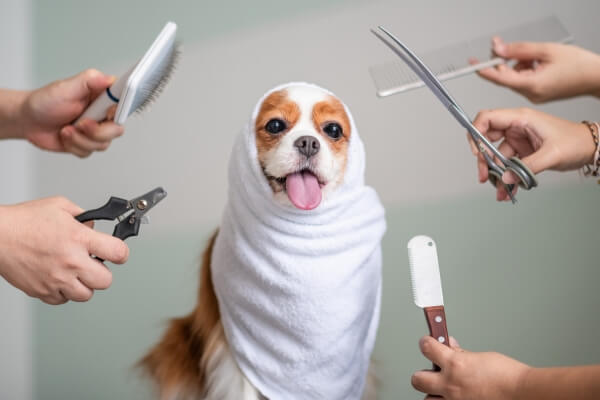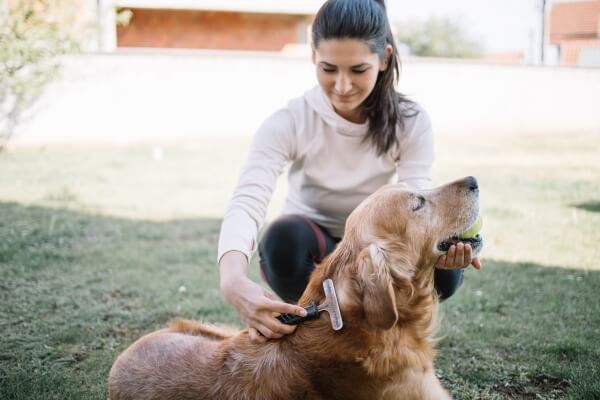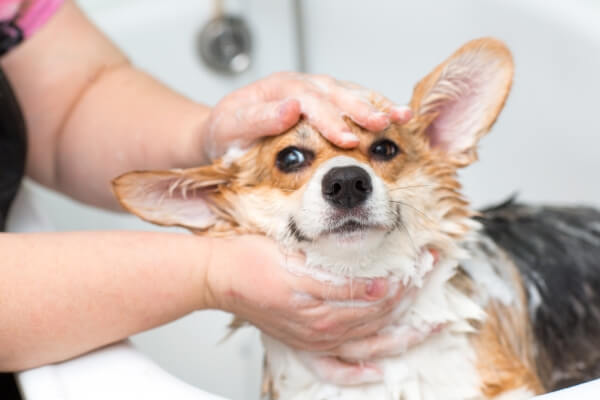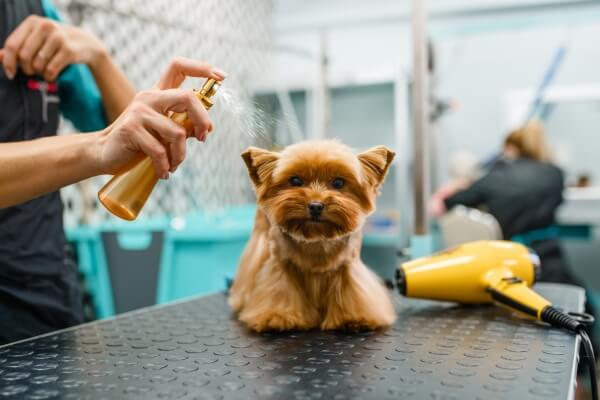How To Prepare Your Dog for the Groomer
If your dog’s not prepped for styling by a pro, it can be cruel and unfair to you and your pet — so you need to know how to prepare your dog for the groomer.
Admittedly, grooming your dog at home is both necessary and beneficial — especially to keep dander levels at bay and to prevent its coat from matting. However, occasional visits to an expert will ensure your dog’s fur and appearance remain in top condition — and help to keep infections at bay.
But, thrust your canine unexpectedly into the hands of a clipper-toting stranger, and you’re asking for trouble.
Here’s my advice on how to prepare your dog for grooming by a professional.
Why You Need To Know How To Prepare Dog for a Groomer
There are three ‘people’ involved in any professional grooming visit — your dog, you, and the groomer. And, without any prep, you’re all going to suffer.
Most importantly, think of your canine.
You can’t expect a dog that has no idea of what’s going on to behave calmly or feel safe. They’re dragged from the comfort of their home to an unknown environment and mounted upon a strange, high table.
A complete stranger walks in, and suddenly they’re getting these sharp metal things — some of them making weird buzzing sounds — and they’re touching them with them. And then, the dog’s gonna go — That’s not right! You can’t do that to me! It’s just going to freak out — especially if it’s already a nervous dog by character.
What’s more, you might have to watch your dog getting groomed in this state of panic, fear, or stress. Since it was a puppy, you’ve done everything to make your dog feel comfortable and happy — now, you have to cope with the fact you’ve put your animal in this awful position and its suffering. And it’s all your fault!
And finally, without any preparation for your dog — it’s cruel to send it to an unsuspecting groomer.
Not only does it make their job a hundred times more difficult, but it can also be dangerous. A scared and anxious dog will snap, bark, scratch, fight, and at worse, bite. And you, as the owner, are going to be responsible for any injury caused.
Getting your dog over grooming anxiety before you take it to the salon saves all three of you stress and worry — and can even make grooming visits a pleasurable experience that everyone looks forward to.
How To Calm a Dog for Grooming
Let me tell you something.
Often, when I’m at dog shows and chatting with groomers, the first thing they tell me is how much they hate Lagotto Romagnolos — because they don’t stand still and hate to be groomed. All they want to do is bite.
And, while they’re telling me how much they dislike styling Lagottos, my dog is standing by my side, perfectly behaved, and remaining still!
I tell the groomers — it’s not the breed, it’s the owners! Tell the damn owners!
I’ve dedicated time and love to training and calming my dog for all situations — especially being faced by a groomer. And I wish everyone else would do the same.
These are my grooming for dogs preparation top tips:
Familiarize Your Dog With Manual Equipment
One of the most alarming things for unsuspecting dogs getting groomed is the unusual tools and equipment that are suddenly thrust into the dog’s personal space.
So, gather together at home the items that will most likely be used by the styling pro, such as:
- Comb.
- Brush.
- Scissors.
- Nail clippers.
- Water sprayer.
Introduce your dog to these tools, allowing them to see and smell them. And, when they are comfortable, slowly move them around your dog’s body. If they make a sound, such as scissors or clippers, gently click them a few times — if your dog is happy, increase the intensity.
And wherever possible, use them on the dog — the easiest being the comb and the brush. Give them a couple of passes through the coat, and then praise, reward, and repeat — until your canine is happy with longer sessions. And, if possible, cut a little hair or clip a single nail. Slowly, slowly is the key.
Introduce Electrical Equipment to Your Dog
Usually, the two main electrical grooming tools are the blow dryer and clippers. Their strange sounds, vibrations, feel, and heat can be the most unnerving for your dog, so it’s important they know what they are before they visit the groomer.
So first, introduce both these pieces of equipment to your dog.
And by introduce, I don’t mean stick the blow dryer onto high power and blast your canine full in the face.
Blow Dryer
Initially, keep it unplugged. Sit on the floor with your dog, position the blow dryer among their favorite toys, and simply wait until your canine sniffs or nudges it. When this happens, praise and give a treat.
Once you feel your dog is content being around the blow dryer, plug it in and switch it on for a few seconds — but don’t point it at the dog. Don’t make the event dramatic, just calmly switch it on, look away, appear untroubled, and switch it off. Repeat.
When you feel your dog is ready, allow the air stream to blow over the dog — but not on its face at the start — from a significant distance, and gradually bring it closer. All the time, keep the intensity and length of exposure within your dog’s comfortable limits.
Clippers
First, follow the same process of placing the clippers among toys as for the blow dryer.
If you haven’t got any dog clippers at home, human hair clippers, beard trimmers, or an electric toothbrush are excellent substitutes. In fact, anything that vibrates — if you know what I’m saying!
In a similar way to the blow dryer, switch the clippers or mock-clippers on for a short time and let the dog hear the buzz. I also recommend laying them, while they’re vibrating, on a hard surface. This can prepare your dog for the groomer putting down the clippers on the grooming table — which amplifies the sound.
When your dog is happy, move the clippers or toothbrush around your canine, so it becomes accustomed to the sounds coming from different locations.
With both the blow dryer and clippers, your job is to teach them to be calm and to be relaxed — showing them that this is not going to hurt. And, continually, praise and reward!
Brush or Comb Their Coat Frequently
When I’m asked how often should a dog be groomed, my response is straightforward — when they need it.
Regularly combing and/or brushing your dog keeps them healthy, ensures their coat is in good condition, and removes dander. However, in most cases, this only needs to be done around once a week — unless they’re serious outdoor explorers who come home covered in mud, dirt, and pieces of bracken.
Some dogs, especially the naturally curly breeds like Lagottos, will frizz if you brush them. This can result in mats that can only be removed by shaving — so if your dog is curly-haired, only comb.
This home grooming time not only accustoms your dog ready for professional attention, but also reduces the amount of correcting, fixing, and rectifying the groomer has to do before styling.
Bathing
Bathing your canine for the first time at the dog salon will leave your dog traumatized after grooming.
So, it’s important you wash your dog at home a few times before taking them to the experts. It doesn’t have to be every week or month or whatever the trendy advice is this week — just when it smells.
And, always comb through the coat when they’re virtually dry. Otherwise, you can create bath mats — stubborn knots, deep in the coat and close to the skin, which cause pain. These, again, will need to be shaved off by the groomer.
Before Grooming, Exercise Your Dog
Wherever possible, play with or walk your dog before the grooming appointment.
If it’s their first time at the groomers, your dog will already be pumped full of adrenaline — this doesn’t need to be made worse by also being packed with pent-up natural energy.
A groomer doesn’t want a bouncy, playful dog, wriggling around on their styling table while they’re wielding sharp scissors and clippers — both for their safety and that of your canine.
How To Prepare Puppy for Grooming
One of the questions I’m most frequently asked is how to prepare a puppy for grooming?
To be honest, the process is much the same as for an adult dog — just more slowly and much more patiently.
When Can a Puppy Be Groomed?
Ask any online ‘expert’ or forum about when to groom a puppy and they’ll tell you around 10-12 weeks.
Okay, maybe you might consider their first pro cut around this time, but the actual grooming, teaching, preparation, and groundwork can be done earlier.
Puppies are inquisitive, playful, and unaffected by past experience — the sooner you start to prepare the dog, the easier and more productive it will be.
How To Prepare Puppy for First Grooming
Table and Tools
Start with the most basic of all training — getting them used to standing on a table.
It sounds simple, but for the puppy, it’s a novel experience. Most likely, they’ve spent most of their time running around on the floor — the highest they’ve probably ever been is on your sofa. Unexpectedly thrust them onto a high grooming table, and it’s the same as you leaning over the edge of a skyscraper.
Put them on your dining table and get them to stand up. That’s it, just for a few seconds. Then reward them, and then let them play. The next time, try to make them stand up for a minute. Always praise and reward, and increase the length of time.
Then, when they are happy, you can very slowly introduce them to the tools in the same way as you do for adult dogs. There doesn’t need to be any cutting or trimming, just allow them to become accustomed to the sights, smells, and sounds of grooming equipment.
Touching
You have a puppy, and naturally, you’re obsessed with touching it.
However, apart from back strokes, chin rubs, and tummy tickles, where else are you touching your dog?
When your dog goes to the groomer, it’s going to be touched, manipulated, cut, trimmed, brushed, combed, and dried all over its body. If it gets handled in an area of its body that’s unused to human contact — especially by a stranger — it’s not going to react calmly.
Therefore, from the earliest age, handle your puppy everywhere, every day:
- Touch and pluck their ears.
- Hold, raise, and lower their tail.
- Wiggle, divide, and pull their toes.
- Touch their pads.
- Stroke their feet.
- Run your fingers around their eyes, nose, and mouth.
- Hold their head still for a few seconds.
- Shake paws.
- Run your hands from the top of their legs down to their feet.
How Long Does Dog Grooming Take?
The more your dog is prepared, the shorter the time it will take to groom! If the groomer has a relaxed, unmatted canine their job is relatively easy.
That said, a grooming session can take anywhere from 30 minutes to three hours, depending on factors such as:
- Services you ask for.
- General groom or show styling.
- Breed of your dog.
- Size of your dog.
- Current coat condition.
- Coat type.
- Behavior and personality.
- Any allergies or medical conditions.
However, if you’re told that the grooming will take six to eight hours — alarm bells should start to ring. Loudly.
I know of groomers that knock dogs out — sedating them and then confining them in muzzles. They’ll say something like, just drop your dog off at eight o’clock and pick it up at six.
Grooming doesn’t take that long. I know exactly what they’re doing — they’re going to give the dog anesthetic, and that’s how long they need to wait for it to wear off. I want no part of this practice, and neither should you.
How do groomers keep dogs still? Through experience, education, patience, a love for animals, and having the benefit of cutting a dog that’s been well-trained by its owner — not through the injection of possibly fatal drugs.
What To Do If You’re Not Happy With Your Groomer
So, your dog has been well prepped, you take them to the groomer, explain to them what style or cut you want so it’s clear, and after the styling session, you’re not happy with the result. What happens next?
Before I tell you, let me ask you something…
How many times have you been to a hairdresser, and at the end of the session, the hairdresser gets their little mirror and shows you the back of your head? And they say, how’s that, is it all ok? And you say, Yeah. That’s great. Thanks. It’s super.
And you hand over your money, smile and leave. Then you get into your car and say, I hate this. It looks ridiculous. I can’t stand it.
The same happens with groomers.
What drives me insane is when I see one of the Lagottos I’ve bred with their owners, and they say, Oh, I’ve just come from the groomers, and this is what my newly styled dog looks like.
And I’m like, Oh my god, what have you done?! He’s all fluffy! (Lagottos shouldn’t be fluffy!). He looks stupid! Why didn’t you say anything?
Look, I’m trying to teach everybody this — if you don’t like it, don’t pay for it. Tell the groomer to fix it. Don’t walk out until it’s sorted. I’m not saying be rude. always be polite, calm, and explain clearly the issues — but don’t accept second best or the wrong cut.
A responsible and professional groomer will sort it out. And if they won’t, take your custom elsewhere next time.
Prepping Your Dog for the Groomer — The Bottom Line
Training your dog ready for the groomer means a contented, happy, and gorgeous-looking canine — and saves you and the groomer stress and worry.
All it takes is a few minutes every day to show your dog that scissors, clippers, brushes, and blow dryers are nothing to be afraid of. And, the earlier they start with this training, the more relaxed they will be.
So, now you know everything about how to prepare your dog for the groomer — so get started today!

